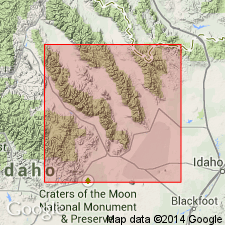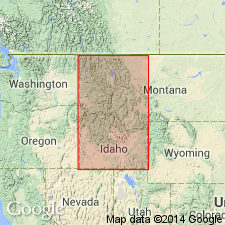
- Usage in publication:
-
- Bluebird Mountain Formation*
- Modifications:
-
- Named
- Dominant lithology:
-
- Sandstone
- Limestone
- Siltstone
- Quartzite
- AAPG geologic province:
-
- Snake River basin
Summary:
Pg. 2, 4, 18-20, figs. 1-6. Bluebird Mountain Formation. Present in White Knob Mountains, southern Lost River Range-Arco Hills, southern Lemhi Range, and southern Beaverhead Mountains, south-central Idaho. Lithology varies from range to range. At type, consists of medium-gray to medium-light-gray, very fine-grained, quartzose, generally quartzitic, mostly thin-bedded, cliff-forming sandstone which weathers light-brown, interbedded with minor beds of gray dolomite and limestone. Siliceous nodules as much as 12.5 cm (5 in.) in diameter are present in several beds, and small-scale crossbedding is present locally. Thickness 345 feet (105 m). Gradationally underlies Bloom Member of Snaky Canyon Formation (both new); contact placed at the base of lowest thick sequence of limestone beds. Gradationally overlies Big Snowy Formation; contact placed at base of lowest thick, calcareous, very fine-grained, ledge-forming, quartzose sandstone. To the west, overlies Arco Hills Formation (new), Surrett Canyon Formation, or White Knob Limestone. Is Shannon's (1961, GSA Bull., v. 72, no. 12) unit C of southern Lost River and Lemhi Ranges; unnamed units of Mapel and others (1965, Doublespring quadrangle) and Mapel and Shropshire (1973, Hawley Mountain quadrangle). Age is Late Mississippian (Chesterian), based on fossils (foraminifers, conodonts, and brachiopods); Mamet microfossil zone 19 (Mamet and Skipp, 1970). Authors propose an arbitrary northern limit for the Arco Hills, Bluebird Mountain, and Snaky Canyon Formations at about Lat. 44 deg. 30 min. N.; volcanic rocks along northeast margin of Snake River Plain provide natural southern limit. Report includes correlation chart, measured sections, fossil list, geologic sketch map.
Type section (=type section of Bloom Member of Snaky Canyon Formation): about 3.5 mi (5.8 km) south of Bluebird Mountain on west flank of Gallagher Peak and on east side of saddle between Copper Mountain and Gallagher Peak, in secs. 29 and 30 (unsurveyed), T. 10 N., R. 31 E., [in vicinity of Lat. 44 deg. 10 min. 17 sec. N., Lat. 112 deg. 48 min. 19 sec. W.], Copper Mountain 7.5-min quadrangle, [Targhee National Forest], Clark Co., ID. Named from Bluebird Mountain, [Lat. 44 deg. 13 min. 25 sec. N., Long. 112 deg. 47 min. 51 sec. W. (from USGS GNIS database and ACME Mapper 2.0, accessed on Darwin's 200th birthday, 2009)].
Reference sections (nos. 2 to 5 =reference sections of Arco Hills Formation) --all in ID: (1) east of town of Arco, Arco Hills, in N/2 NE/4 sec. 31, T. 4 N., R. 27 E., Butte Co. (=type section of Arco Hills Formation); (2) north of junction of Wood Canyon and Antelope Creek, southern White Knob Mountains, in NW/4 sec. 29 and N/2 sec. 30, T. 5 N., R. 25 E., Custer Co.; (3) southern Lemhi Range, in SE/4 sec. 6, T. 6 N., R. 30 E., Butte Co.; (4) ridge east of East Canyon, southern Lemhi Range, in SE/4 sec. 36 (unsurveyed), T. 7 N., R. 29 E., Butte Co., (5) north side of Skull Canyon, Blue Dome area, southern Beaverhead Mountains, in NW/4 NW/4 sec. 28 and NE/4 NE/4 sec. 29, T. 10 N., R. 30 E., Clark Co.
Source: Publication; US geologic names lexicon (USGS Bull. 1564, p. 16); Changes in stratigraphic nomenclature, 1979 (USGS Bull. 1502-A, p. A8).

- Usage in publication:
-
- Bluebird Mountain Formation*
- Modifications:
-
- Age modified
- AAPG geologic province:
-
- Idaho Mountains province
Summary:
The age of the Bluebird Mountain Formation changes northeastward in the Idaho Mountains province across southeast ID from Chesterian age in Wood Canyon and Timbered Dome in the White Knob Mountains of Custer Co to Chesterian and Morrowan at Gallagher Peak in the Beaverhead Mountains of Lemhi Co. The Bluebird Mountain is a terrigenous unit beneath the Bloom Member of the Snaky Canyon Formation. The Mississippian-Pennsylvanian boundary lies near the base of the Bloom at Wood Canyon and Timbered Dome. The Mississippian-Pennsylvanian is thought to lie in the upper 13+/-m of the Bluebird Mountain at Gallagher Peak. Columnar sections.
Source: GNU records (USGS DDS-6; Denver GNULEX).
For more information, please contact Nancy Stamm, Geologic Names Committee Secretary.
Asterisk (*) indicates published by U.S. Geological Survey authors.
"No current usage" (†) implies that a name has been abandoned or has fallen into disuse. Former usage and, if known, replacement name given in parentheses ( ).
Slash (/) indicates name conflicts with nomenclatural guidelines (CSN, 1933; ACSN, 1961, 1970; NACSN, 1983, 2005, 2021). May be explained within brackets ([ ]).

